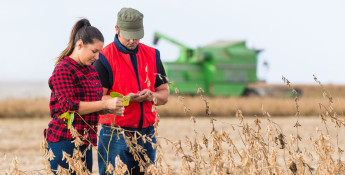By Dixie Vogel on January 31, 2018
Assessing the Risk (of GMOs)
Build Confidence in Your Food Choices

Some people are terrified of GMOs. Others are wholehearted advocates. I suspect most live somewhere in between: not especially frightened or especially enthusiastic about GMOs. Maybe people are a bit wary because they hear such strong opinions on one side or another but remain unsure.
Who wants to feel unsure about what they’re eating? Building confidence through learning is exactly how to become your own food guru. So, I set about to learn the facts about GMO risk.
Nothing in life is devoid of risk. Weighing potential harm against benefit and mitigating risks whenever possible is part of every sound decision-making process. So, it makes perfect sense to use the same process to approach GMOs.
To be clear, GMOs have been around for more than 20 years, with more than 4.9 billion acres of genetically engineered crops planted across 28 countries. Billions are already eating GMO food, whether they are aware or not. In this time, there’s not been a single verified death or illness traced to GMOs.
People are understandably suspect of anything that seems both new and “unnatural.” Most don’t realize GMOs are not the first types of intentional genetic alterations made to our food. For decades now, thousands of crops have been genetically altered by chemicals or radiation, known as “mutagenesis.” While the outcome of mutagenesis is without question genetic modification—though random and impacting far greater amounts of DNA than GMO—mutagenic food is considered safe and can even be classified as organic.
So, although GMOs may be relatively new in terms of humanity overall, genetic modification to food is far from untested. The overwhelming bulk of science, both in the U.S. and internationally, from sources outside and inside the agricultural industry, have found no appreciable differences in the safety of GM crops versus conventional crops.
However, that doesn’t mean it’s not still prudent to assess risk. Any time you’re working with plants or animals we eat, there is potential for environmental or health issues to arise. That’s why scientists actively explore potential risk as a matter of course in GMO research.
Environmental risks might run along the lines of the loss of effectiveness of a pesticide when the function is bred into the plant, producing a plant strain that’s considered invasive or the potential for adverse effects on wildlife. These sorts of issues are all studied during GMO development.
For health, the most salient risk would be allergy potential. Scientists look at whether the source plant is allergenic, check reactions in sensitive individuals and examine the newly introduced protein itself to see if it’s resistant to digestion and abundant—conditions conducive for an allergen to develop.
So yes, there are some common risks in producing GMOs. And yes, the scientists look to assess and mitigate these risks as part of the GMO development process. Exactly as it should be.
But don’t we need more GMO research to be sure?
In truth, GMOs are the most studied foods in human history. In the U.S., it takes an average of 13 years of research and multiple agencies’ approval for a GMO product to get to market.
There is a very coordinated approach to GMO regulation. The National Institute of Health (NIH) oversees GMO research and development, in tandem with a researching institution’s biosafety guidelines. The United States Department of Agriculture’s Animal and Health Inspection Service (USRDA-APHIS) regulates field trials. The Environmental Protection Agency (EPA) oversees pesticide trials and use, including those involving GMOs. The Food and Drug Administration (FDA) evaluates safety of both our food and livestock feed. That’s a whole lot of government agencies watching over GMOs.
Before a genetically engineered crop can be sold commercially, developers petition APHIS for what’s known as “non-regulated status.” Researchers are required to provide a full risk assessment, describing the biology of the non-modified plant as well as the genetically engineered plant, outlining the differences between the two and describing the purpose for modification. They must provide a full nutritional profile, describe known or suspected allergenic potential, and if the food is known to be allergenic, undertake comparison studies between the genetically modified and conventional food to see how they may differ.
Researchers must also evaluate environmental impact to be sure GMO plants will not negatively affect existing ecosystems. And they are required to demonstrate confinement of the new biological material even down to seed transportation, overseen at both state and federal levels.
Each step of the process must be verified and documented. All approval is on a case-by-case basis.
It would be fair to say GMO research is best described as continual and ongoing. That leaves it up to each individual to decide if the research being done is enough to satisfy them personally.
Isn’t GMO just a profit scheme?
People are sometimes suspicious of GMOs because it seems to be exclusively the purview of “Big Agra.” But there is a reason why only the largest of corporations usually work with GMOs: cost.
Research, testing and the expense of regulatory compliance adds up to millions for GMO development. Between 2003 and 2012, the average cost to bring a GMO food to market was $136 million.
GMO work remains expensive in part because it’s the process of creating the GMO that’s regulated, not the end product. For example, “Roundup Ready” soybeans are now off patent, but each batch must go through the same regulatory process as if they were being created for the first time. This makes GMO development cost-prohibitive for all but the largest of companies.
Regulation varies from state to state and country to country, adding to the budget required for marketing GMOs. While some might interpret extensive regulation as soft evidence GMOs are risky, it’s useful to remember regulation is a political process, not a scientific one. Public perception of GMO risk spurs additional regulation, not the other way around.
Can GMO foods alter our genetics?
Some worry ingesting foreign genetic material could potentially alter their own genetics, finding the idea understandably unsettling. What many don’t realize is almost all our food, conventional or GMO, already contains DNA—and that DNA would be classified as “foreign” to our bodies.
Despite the saying, “you are what you eat,” scientists have yet to discover DNA that can survive a trip through the gut and take up residence in our bodies, let alone produce a mutation. Our digestive system is perfectly suited to digesting and discarding foreign DNA.
To put it in perspective, the risk of a person experiencing a genetic change due to eating GMO food is exactly the same as the risk of experiencing a genetic change due to eating conventional food. It’s never been known to happen, even once.
Each gene produces exactly one protein, so there is not as much guesswork as one might think in modifying a gene (or very few genes). A principle called “The Central Dogma of Molecular Biology” outlines the process: once DNA has transformed into the RNA that carries instructions to produce a protein, that process doesn’t reverse itself. The trait created by the protein produced in the GMO plant is the end of the line, as far as alterations go.
In other words, not a single protein in all of human history (including those introduced via GMO) has ever been discovered magically transforming back into anything that could lead to genetic changes in another living organism. Fortunately for us, the vast variety of DNA we encounter in daily life is both highly predictable and completely harmless.
Bottom Line: should we eat GMOs?
“GMOs aren’t good or bad. You have to look at them on a case-by-case basis,” Dr. Trick said.
I agree with him completely. The statement meant even more coming from someone who is immersed in GMO research. A technology may inspire fear or confidence in different people, but it’s not the technology in and of itself that’s helpful or hurtful. Benefits or detriments come from what you do with a given technology.
In my personal investigation, every bit of material I’ve found painting a scary picture of GMOs included such glaring scientific flaws or outright deceptions, I found them lacking credibility. It’s been a while since I sat through a college statistics class, but there was one message my professors successfully drilled into my brain: not everything presented as science is actual science.
On the other hand, those I’ve met working with GMOs impressed me with their sincerity. Their expertise was tremendous. I could feel the care these researchers took in distilling the scientific concepts into language that was both accurate and understandable to me as a layperson.
What struck me most, though, was their excitement over the possibilities of GMOs to help so many people, in so many ways. Their enthusiasm was infectious.
I’m genuinely thrilled so many care about the well-being of themselves and others, no matter what their conclusions. That concern is what’s made GMOs a hot topic. Discussion is powerful. Informed discussion is more powerful still. I now feel informed enough, I might even stop ducking out of some of those GMO conversations.
I’m grateful I have the freedom to make these choices for myself. Personally, I feel good supporting the goals of GMO work as I understand them. I’ll continue to eat what I want, including GMOs.
In fact, if I have a choice between food labeled as GMO-free and food that is not, I’m going to reach for the latter. I see buying GMO food as a very humble contribution to supporting the goals of GMO research. I appreciate folks doing the best they can to do good in the world. If I can be a small part of it, I will gladly.
If you’d like to explore GMOs for yourself, you can find more information on the GMO Answers website.
Sources
Dr. Thomas Clemente, Center for Plant Science Innovation. Personal interview, December 5, 2017.
Dr. Harold Trick, Department of Plant Pathology. Personal interview, November 20, 2017.
Dr. Harold Trick, Kansas State University Research & Extension Presentation. “The Science of GMOs: What you need to know to make an informed assessment.” May 17, 2017. Accessed online, January 16, 2018. https://www.dropbox.com/s/r7v26kh78tjonfj/EMFV%20Manhattan%20May%202017.ppt?dl=0
Friedman, David H. Scientific American. “The Truth About GMO Food,” September 1, 2013. Accessed online, January 16, 2018. https://www.scientificamerican.com/article/the-truth-about-genetically-modified-food/





